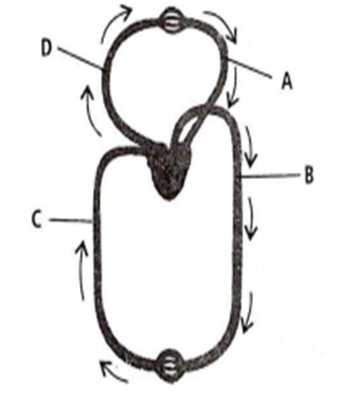 Multiple Choice Questions
Multiple Choice QuestionsAn artificial pacemaker is implanted subcutaneously and connected to the heart in patients
having 90% blockage of the three main coronary arteries
having a very high blood pressure
with irregularity in the heart rhythm
suffering from arteriosclerosis
Assertion: Pulmonary circulation consists of flow of deoxygenated blood from right ventricle to the lungs and flow of oxygenated blood from lungs to the left atrium.
Reason: Systemic circulation consists of flow of oxygenated blood from the left ventricle to all parts of the body and deoxygenated blood from different parts to right atrium
If both assertion and reason are true and reason is the correct explanation of assertion.
If both assertion and reason are true but reason is not the correct explanation of assertion.
If assertion is true but reason is false.
If both assertion and reason are false.
Assertion: ADH and RAAS work in response to low blood volume and blood pressure.
Reason: ANF works in response to high blood volume and blood pressure.
If both assertion and reason are true and reason is the correct explanation of assertion.
If both assertion and reason are true but reason is not the correct explanation of assertion.
If assertion is true but reason is false.
If both assertion and reason are false.
The given figure shows schematic plan of blood circulation in humans with labels A to D. Identify the labels along with their functions and select the correct option.

C- Vena Cava - takes blood from body parts to right atrium, Pco2 = 45 mm Hg
D- Dorsal aorta - takes blood from heart to body parts, Po2 = 95 mm Hg
A- Pulmonary vein - takes impure blood from body parts to heart, Po2 = 60 mm Hg
B- Pulmonary artery - takes blood from heart to lungs, Po2= 90 mm Hg.
Mature RBCs lose their ability for
DNA replication
Anaerobic respiration
Aerobic respiration and DNA replication
Aerobic respiration, DNA replication and RNA synthesising machinery
In a standard ECG which one of the following alphabets is the correct representation of the respective activity of the human heart
S- start ofsystole
T- end of diastole
P- depolarisation of the atria
R - repolarisation of ventricles
Assertion: The enlarged Q and R waves indicate myocardial infarction.
Reason: The QRS complex represents ventricular repolarisation.
If both assertion and reason are true and reason is the correct explanation of assertion.
If both assertion and reason are true but reason is not the correct explanation of assertion.
If assertion is true but reason is false.
If both assertion and reason are false.
Assertion: Human heart is myogenic.
Reason: The contraction is initiated by a specialized patch of modified heart muscles without requiring stimulation from nerve cells.
If both assertion and reason are true and reason is the correct explanation of assertion.
If both assertion and reason are true but reason is not the correct explanation of assertion.
If assertion is true but reason is false.
If both assertion and reason are false.
Assertion: Pulmonary circulation consists of flow of deoxygenated blood from right ventricle to the lungs and flow of oxygenated blood from lungs to the left atrium.
Reason: Systemic circulation consists of flow of oxygenated blood from the left ventricle to all parts of the body and deoxygenated blood from different parts to right atrium.
If both assertion and reason are true and reason is the correct explanation of assertion.
If both assertion and reason are true but reason is not the correct explanation of assertion.
If assertion is true but reason is false.
If both assertion and reason are false.
